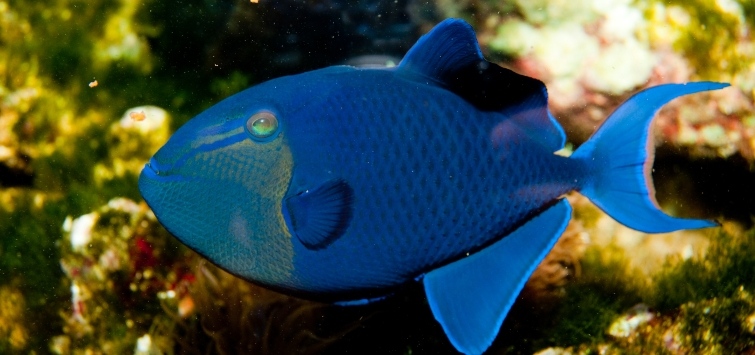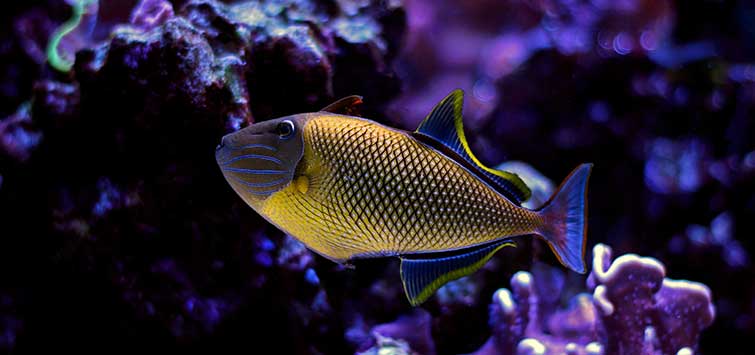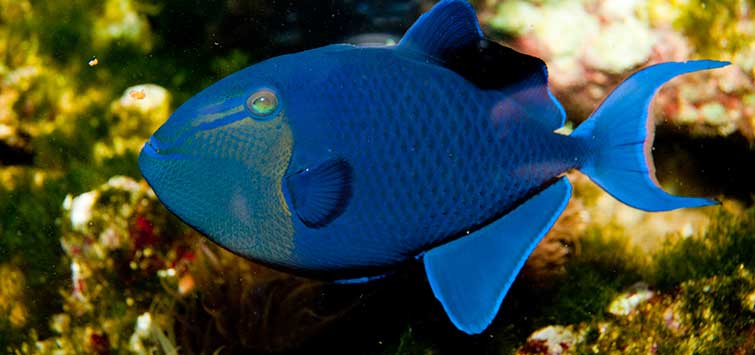Triggers in My Aquarium
Author: Bob Goemans
Veteran fishkeeper Bob Goemans recalls his various experiences with the triggerfishes, with details on their varied personalities and care requirements.
Triggerfish Basics
Triggerfish derive their common name from their ability to lock and unlock their first dorsal fin. This fin is normally retracted and carried in a groove on the upper body. When frightened, the fish will dart into a crevice or branch of coral and raise this fin, securely locking itself into its place of protection. This first raised and locked spine can only be released when the second spine—the trigger—is depressed into its recess.
There are many traits and habits that make the triggerfishes interesting. They are definitely fish with personality! They have an odd form of swimming where the anal and dorsal fins are used for most of their movement; nevertheless, when bursts of speed are needed they use rapid movements of the tail. Besides being very hardy and beautiful, these fishes also appear to be quite intelligent. However, most are quite pugnacious and some have been known to attack divers when they got too close to their territory. Triggers are better kept with large moray eels, snappers, angelfish, and tangs, as they can’t be trusted with smaller tankmates.
Biology, Behavior, and Taxonomy
The family Balistidae (triggerfishes) contains 10 genera and 40 species, with few being suitable for the average home aquarium. Like angelfish and surgeonfish, triggers have laterally compressed bodies and small mouths, but they have strong jaws and chisel-like teeth for crushing hard-shelled prey. Their scales are plate-like, and while they do not have pelvic fins, there is a pelvic spine. They also have three dorsal spines, but in some species the third spine is underdeveloped.
Diet
Triggerfish are carnivores, and their diet consists mainly of small fish, starfish, crabs, shrimp, snails, and urchins, so they are best kept to a fish-only aquarium—or at least one without tasty inverts.
Physical Characteristics
A triggerfish’s head often takes up a third of its body length and contains well-developed and independently moveable eyes, which are set high up on the body to protect from urchin spines. In fact, besides being very capable at breaking off urchin spines so as to get to the central meaty body area, triggerfish are also capable of expelling a jet of water from their mouth to turn urchins over so they can get at their soft underbelly.
Resting
In aquaria, if a trigger’s diet is inadequate it will tend to lose its vivid colors, but note that it is normally paler when resting during nighttime hours. Normally, they rest on rock ledges, amongst coral branches and/or in caves and crevices.
Housing
Triggers should be housed with small pieces of seashell on the sand bed surface, since they like to bite on them or turn them over in the search of prey. Better these shells being their “toys” than other aquarium decor! And besides, the shells help keep the fish’s teeth worn-down (their teeth can actually get too long and pointed and cause them some difficulty in feeding).
Because of their aggressiveness, I’ve kept very few triggerfish that I would select a second time, yet the ones I did maintain are worth mentioning, as is one species that I would not put into an aquarium with any tankmates.
Recommended Triggerfish
Odonus niger
I’ll begin with my personal favorite, Odonus niger, which has been in a variety of my aquariums. It is known by several different common names, including the black triggerfish, blue triggerfish, red-toothed triggerfish, red-fang triggerfish, or often simply the Niger triggerfish. It hails from the Indo-Pacific: Red Sea to Durban South Africa, Marquesas and Society Islands, and southern Japan to the Great Barrier Reef and New Caledonia, where it normally inhabits shallow coastal waters to outer reef drop-offs at depths of 30 to 100 feet (9 to 30 meters), and where it reaches a length of about 20 inches (50 cm). However, most of these that I’ve seen in the trade are far smaller, with sizes varying from an inch (2½ cm) to about 8 inches (20 cm).
The more mature members of O. niger have teeth that are really red, and their body coloration seems to depend on lighting and the time of day—usually blue, but sometimes appearing bluish-green or a dull green color. The large head area of O. niger is highlighted with blue lines and dots around the snout, and it is paler than the rest of the body, making it stand out. Its tail also has long filaments on the upper and bottom trailing edges. For some reason, I’ve called this my “Darth Vader” fish, as it seems to have an uncanny ability of awareness about it. It was always either visible or not at just the right times, and when it came time to eat it was not to be denied its share of the food!
I’ve always purchased this beauty fairly small—e.g., less than 3 inches (7½ cm)—and always housed it with tankmates at least its size, as it would consider anything smaller a meal. In fact, it has been kept with large angelfish, surgeonfish, moray eels, and even lionfish, which was a much slower swimmer but was always capable of successfully fending off any interest in its fins on the part of the triggerfish. Nevertheless, the triggerfish had to be fed first, as it was the quickest in these tanks.
Hardy might be an understatement, and bulletproof another; this is a specimen that is not fussy about water quality nor most tankmates, with the exception being others in its own family, as one triggerfish per tank is the general rule. When it came to its diet, anything meaty was just perfect, and I often brought back urchins from my trips to nearby Mexico just to watch Darth Vader go through his feeding antics. In between, I fed enriched defrosted pieces of fish and shrimp flesh, and mollies when available. (I should note that information has come to me recently that seawater-raised mollies may now again be available, which would be a perfect live food for these carnivores, as well as for lionfish: check out www.saltwatermollies.com.)
Balistoides conspicillum
Another favorite of mine has been the clown triggerfish Balistoides conspicillum, which attains a length of about 20 inches (50 cm). It hails from the Indo-Pacific Ocean: East Africa south to Durban South Africa, Indonesia, Samoa, southern Japan, and New Caledonia, where it swims in open deep drop-off areas, yet seeks local caves to hide in.
Without a doubt this is a very beautiful fish. The young have large white spots over most of their body and head, and a yellow snout area. As they mature, a yellow saddle area containing small bluish spots starts to develop around the first dorsal fin. The yellow on the snout recedes to just a small area around the mouth and is bordered by a white line. The few specimens I’ve kept over the years were all about 6 inches (15 cm) or slightly smaller and had their mature color pattern.
Mine were maintained in systems no smaller than 125 gallons, and their tankmates were generally tough damselfish, large surgeonfish, and moray eels. Clowns can be considered somewhat aggressive, and are not to be trusted with anything very small or with a meek disposition! In fact, one of my tough sergeant major damselfish that I brought back from Mexican waters went missing a week after a clown was added. I never did find out what happened to it, but it could have been the octopus that slipped into that 320-gallon tank from some live rock brought back from some tide pool trips to Mexico (another story for another time). Its requirements are the same as the above-mentioned species, however clowns should have large open areas for swimming.
Xanthichthys auromarginatus and Melichthys vidua
The blue-throat triggerfish Xanthichthys auromarginatus, which attains a length of about 8 inches (20 cm), can be considered quite mild in temper when compared to others in its family. It hails from the Indo-Pacific Ocean: from South Africa north to the Ryukyu Islands and east to the Hawai‘ian Islands. I’ve had this species twice, and both times my 3-inch (7½-cm) specimens were quite mild mannered and well behaved, and they did well in mixed company.
Another that was also well behaved was the pink-tail triggerfish Melichthys vidua, which hails from similar areas as X. auromarginatus, yet gets quite a bit larger at 14 inches (35 cm). Both of these were purchased quite small at about 2 to 3 inches, and they actually made good tankmates and can be considered gentler and better mannered than any others in the triggerfish family.
Rhinecanthus spp.: Not to Be Trusted
I’ve had a few triggerfish that were outside my comfort zone, as they were not completely trustworthy even in mixed company of larger fish. The first was the Picasso, or white-barred, Hawai‘ian triggerfish Rhinecanthus aculeatus, which inhabits most of the world’s tropical seas, e.g., Red Sea and South Africa, east to Hawai‘ian, Marquesas, and Tuamotu Islands, southern Japan, Lord Howe Islands, and also the Eastern Atlantic Ocean—Senegal to South Africa, making it one of the more plentiful triggerfish, and therefore generally the least expensive.
It reaches a 10-inch (25 cm) length and is one of the few triggerfish that will tolerate others of the same species in the same tank; however, they should be added as juveniles—preferably at the same time—if this is to be tried. An odd thing with this species is that it can be heard sleeping! Yes, it snores, actually emitting an audible whirring sound while sleeping. (Actually my wife does the same thing, but she doesn’t believe it!)
Similar in size and coloration is the rectangle triggerfish R. rectangulus, coming from the same areas except the Atlantic region. Also somewhat similar in size and coloration is the Assasi/Arabian Picasso triggerfish R. assasi. R. assasi, however, hails from the Western Indian Ocean, i.e., Red Sea to the Gulf of Oman and the Persian Gulf.
All three of these Rhinecanthus species had basically the same diet and temperament, but liked to rearrange system dÉcor, chew on my temperature-sensing and probe leads, and take a shot at passing fins of larger tankmates. Keep in mind not all my aquaria had sumps, where relocation of some of those items would have been possible, so it was a lesson learned for me.
Pseudobalistes fuscus: A Big Mistake
Probably the biggest mistake I made was with the blue-lined triggerfish Pseudobalistes fuscus, which can get quite large, e.g., 18 inches (45 cm). It hails from the Red Sea to Durban South Africa, Society Islands, southern Japan, Great Barrier Reef, and New Caledonia where it generally inhabits deep reef outcrops. This very pretty fish was purchased quite small and placed in a large 220-gallon system with much larger tankmates. Unfortunately this tank did not have a sump, and when I found this fish taking bites out of my heater cable cord (after it ate every snail in the aquarium), that was the last straw. It wasn’t easy getting it out of that aquarium, but it went back to the local shop for credit towards another purchase.
Some Complete Terrors
Before I close, it’s a must to mention Balistapus undulatus, the undulate, orange-lined, orange-tailed, or yellow-tailed triggerfish, which gets to about 12 inches (30 cm). It hails from the Indo-Pacific Ocean: Red Sea to South Africa, Line, Marquesan, and Tuamotu Islands, southern Japan, Great Barrier Reef, and New Caledonia. This is an easy beauty to identify, as it has a yellowish orange tail with undulating orange lines on a dark green body.
The word “aggressive” does not do this fish justice—“terror” or “demon” might better suit it. Then again, “ferocious” might be the best description. In fact, it’s such an aggressive fish that it can’t be safely kept with anything but itself! And I should note that a good friend kept a full-grown specimen in a 75-gallon glass tank in his shop. If you placed your hand near the tank panel, the fish would attack the panel, which was well disfigured with gouge marks from the trigger’s teeth! This is not something for your home aquarium, especially not with tankmates of any size—unless you’re planning on using them as live food.
Another two in this same “terror” category that are unmanageable in mixed surroundings are the titan triggerfish Balistoides viridescens and the queen triggerfish Balistes vetula. Balistoides viridescens gets to about 30 inches (75 cm) and actually attacks divers, while Balistes vetula is 20 inches (50 cm) and can (and likely will) rearrange aquarium decor, bite airline tubing, break heater tubes, and scratch aquarium side panels.
Make a Cautious Choice
In closing, my favorite trigger has always been the Nigertrigger Odonus niger, and as for two that are somewhat more mild mannered, the blue-throat triggerfish Xanthichthys auromarginatus and the pink-tail triggerfish Melichthys vidua can be considered quite well behaved in mixed company. However, none of these should be considered safe with smaller fish or tasty invertebrates such as shrimp, snails, and urchins, as these will be considered breakfast, lunch, or dinner. Make sure to do your research and choose wisely before adding a trigger to your aquarium.

.png?h=595&iar=0&w=2781&hash=5FD5E69473BCC22199FBFA2FB71B6033)



